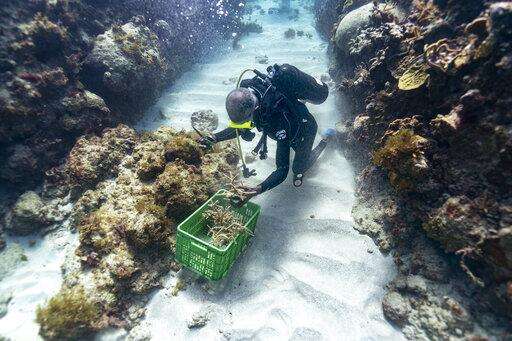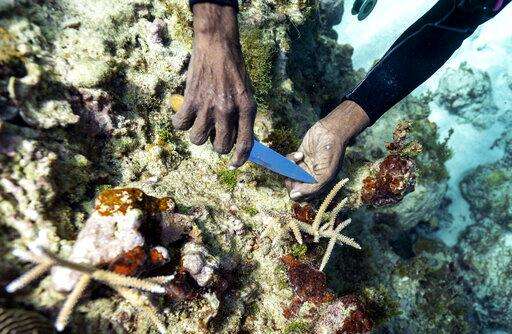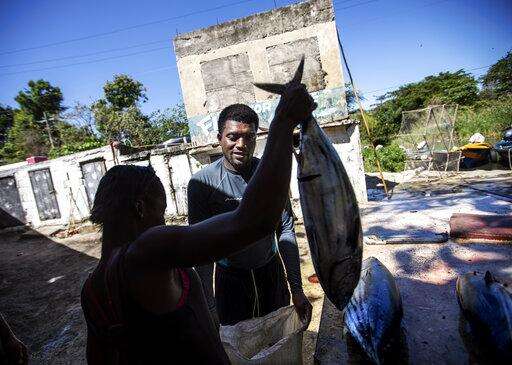White River Fish Sanctuary wardens patrol through the reef of the sanctuary's no-take zone in Ocho Rios, Jamaica, Tuesday, Feb. 12, 2019. After a series of disasters in the 1980s and 1990s, Jamaica lost 85 percent of its once-bountiful coral reefs and its fish population plummeted. But today, the corals and tropical fish are slowly reappearing thanks to some careful interventions. (AP Photo/David Goldman)
The Associated Press
OCHO RIOS, Jamaica (AP) - Everton Simpson squints at the Caribbean from his motorboat, scanning the dazzling bands of color for hints of what lies beneath. Emerald green indicates sandy bottoms. Sapphire blue lies above seagrass meadows. And deep indigo marks coral reefs. That's where he's headed.
He steers the boat to an unmarked spot he knows as the "coral nursery." ''It's like a forest under the sea," he says, fastening his oxygen tank before tipping backward into the azure waters. He swims straight down 25 feet carrying a pair of metal shears, fishing line and a plastic crate.
On the ocean floor, small coral fragments dangle from suspended ropes, like socks hung on a laundry line. Simpson and other divers tend to this underwater nursery as gardeners mind a flower bed - slowly and painstakingly plucking off snails and fireworms that feast on immature coral.
When each stub grows to about the size of a human hand, Simpson collects them in his crate to individually "transplant" onto a reef, a process akin to individually planting each blade of grass in a lawn.
Even fast-growing coral species add just a few inches a year. And it's not possible to simply scatter seeds.
A few hours later, at an underwater site called Dickie's Reef, Simpson uses fishing line to tie clusters of staghorn coral onto rocky outcroppings - a temporary binding until the coral's limestone skeleton grows and fixes itself onto the rock. The goal is to jumpstart the natural growth of a coral reef. And so far, it's working.
Almost everyone in Jamaica depends on the sea, including the energetic 68-year-old Simpson.
Once a spear fisherman and later a scuba-diving instructor, he started working as a "coral gardener" two years ago - part of grassroots efforts to bring Jamaica's coral reefs back from the brink.
Coral reefs are often called "rainforests of the sea" for the astonishing diversity of life they shelter.
Just 2 percent of the ocean floor is filled with coral, but the branching structures sustain a quarter of all marine species. Clown fish, parrotfish, groupers and snappers lay eggs and hide from predators in the reef's nooks and crannies, and their presence draws eels, sea snakes, octopuses and even sharks. In healthy reefs, jellyfish and sea turtles are regular visitors.
With fish and coral, it's a codependent relationship - the fish rely on the reef to evade danger and lay eggs, and they also eat up the coral's rivals.
After a series of natural and man-made disasters in the 1980s and 1990s, Jamaica lost 85 percent of its once-bountiful reefs. Meanwhile, fish catches declined to a sixth of what they had been in the 1950s, pushing families depending on seafood closer to poverty.
Many scientists thought most of Jamaica's coral reef had been permanently replaced by seaweed, like jungle overtaking a ruined cathedral.
But today, the corals and tropical fish are slowly reappearing, thanks in part to a series of careful interventions.
The delicate labor of the coral gardener is only one part of restoring a reef. Convincing lifelong fishermen to curtail when and where they fish and controlling the surging waste dumped into the ocean are even trickier endeavors.
Still, slowly, the comeback effort is gaining momentum.
"When you give nature a chance, she can repair herself," says Stuart Sandin, a marine biologist at the Scripps Institution of Oceanography in La Jolla, California. "It's not too late."
Sandin is studying the health of coral reefs around the world as part of a research project called the "100 Island Challenge." His starting assumption was that the most populated islands would have the most degraded habitats, but he found instead that humans can be either a blessing or a curse, depending on how they manage resources.
When Jamaica's fish populations began to collapse two decades ago, something had to change.
In the past 10 years, more than a dozen grassroots-run coral nurseries and fish sanctuaries have sprung up, supported by small grants from foundations, local businesses such as hotels and scuba clinics, and the Jamaican government.
At the White River Fish Sanctuary, which is only about 2 years old and where Simpson works, the clearest proof of early success is the return of tropical fish that inhabit the reefs - as well as hungry pelicans, skimming the surface of the water to feed on them.
The solution was to create a protected area for immature fish to reach reproductive age before they are caught.
Most of the more established fishermen, who own boats and set out lines and wire cages, have come to accept the no-fishing zone. But some younger men still hunt with lightweight spearguns, swimming out to sea and firing at close-range. These men - some of them poor and with few options - are the most likely trespassers.
Once it became clear that a no-fishing zone actually helped nearby fish populations rebound, however, it became easier to build support. The number of fish in the Oracabessa Bay Fish Sanctuary has doubled between 2011 and 2017, according to Jamaica's National Environment and Planning Agency. And that boosts catches in surrounding areas.
Oracabessa was the first of the grassroots-led efforts to revive Jamaica's coral reefs. Its sanctuary was legally incorporated in 2010, and its approach of enlisting local fishermen as patrols became a model for other regions.
After word got out about Oracabessa, other regions wanted advice.
"The fishermen are mostly on board and happy - that's the distinction. That's why it's working," sanctuary manager Inilek Wilmot says.
Belinda Morrow, a lifelong water-sports enthusiast who runs the White River Marine Association, notes that, in Jamaica, "We all depend on the ocean."
"If we don't have a good healthy reef and a good healthy marine environment, we will lose too much," she says. "Too much of the country relies on the sea."
___
This Associated Press series was produced in partnership with the Howard Hughes Medical Institute's Department of Science Education. The AP is solely responsible for all content.
White River Fish Sanctuary warden and diver Everton Simpson heads out to sea to patrol against illegal fishing at dawn in White River, Jamaica, Tuesday, Feb. 12, 2019. Once a spear fisherman and later a scuba-diving instructor, Simpson started working as a "coral gardener" and warden two years ago, part of grassroots efforts to bring Jamaica's coral reefs back from the brink. (AP Photo/David Goldman)
The Associated Press
Belinda Morrow, president of the White River Marine Association, left, braces herself and Charmaine Webber, with the Environmental Foundation of Jamaica, from the rocking boat as diver Raymond Bailey, right, falls into the water to plant coral on a reef within the protected White River Fish Sanctuary in Ocho Rios, Jamaica, Tuesday, Feb. 12, 2019. (AP Photo/David Goldman)
The Associated Press
Belinda Morrow, president of the White River Marine Association, uses a box with a glass bottom to look underwater from a boat as coral is planted on a reef within the protected White River Fish Sanctuary in Ocho Rios, Jamaica, Tuesday, Feb. 12, 2019. "We all depend on the ocean," said Morrow. "If we don't have a good healthy reef and a good healthy marine environment, we will lose too much. Too much of the country relies on the sea." (AP Photo/David Goldman)
The Associated Press
Diver Lenford DaCosta cleans up lines of staghorn coral at an underwater coral nursery inside the Oracabessa Fish Sanctuary on Tuesday, Feb. 12, 2019, in Oracabessa, Jamaica. In Jamaica, more than a dozen grassroots-run coral nurseries and fish sanctuaries have sprung up in the past decade, supported by small grants from foundations, local businesses such as hotels and scuba clinics, and the Jamaican government. (AP Photo/David J. Phillip)
The Associated Press
Diver Everton Simpson untangles lines of staghorn coral at a coral nursery inside the White River Fish Sanctuary on Monday, Feb. 11, 2019, in Ocho Rios, Jamaica. On the ocean floor, small coral fragments dangle from suspended ropes, like socks hung on a laundry line. Divers tend to this underwater nursery as gardeners mind a flower bed, slowly and painstakingly plucking off snails and fireworms that feast on immature coral. (AP Photo/David J. Phillip)
The Associated Press

Diver Everton Simpson grabs a handful of staghorn, harvested from a coral nursery, to be planted inside the the White River Fish Sanctuary Tuesday, Feb. 12, 2019, in Ocho Rios, Jamaica. When each stub grows to about the size of a human hand, Simpson collects them in his crate to individually "transplant" onto a reef, a process akin to planting each blade of grass in a lawn separately. Even fast-growing coral species add just a few inches a year. And it's not possible to simply scatter seeds. (AP Photo/David J. Phillip)
The Associated Press

Diver Everton Simpson plants staghorn harvested from a coral nursery inside the the White River Fish Sanctuary Tuesday, Feb. 12, 2019, in Ocho Rios, Jamaica. Simpson uses bits of fishing line to tie clusters of staghorn coral onto rocky outcroppings, a temporary binding until the coral's limestone skeleton grows and fixes itself onto the rock. The goal is to jumpstart the natural growth of a coral reef. And so far, it's working. (AP Photo/David J. Phillip)
The Associated Press
Fisherman Oswald Coombs is encircled by tarpon as he cleans his catch on the beach in the fishing village of Oracabessa Bay, Jamaica, Wednesday, Feb. 13, 2019. With fish and coral, it's a codependent relationship, the fish rely upon the reef structure to evade danger and lay eggs, and they also eat up the coral's rivals. (AP Photo/David Goldman)
The Associated Press
Morris Gause, from left, Nigel Simpson and Andre Ramator, peer over the end of a dock to look at fish in the Oracabessa Fish Sanctuary, in Oracabessa Bay, Jamaica, Tuesday, Feb. 12, 2019. "Most people, what they see, and why people have bought into it is walking down to the beach and looking into the water and seeing fish you know," said sanctuary manager Inilek Wilmot. (AP Photo/David Goldman)
The Associated Press
A vendor sells coconut water in a shopping area popular with cruise ships and tourists in Ocho Rios, Jamaica, Friday, Feb. 15, 2019. Jamaica's coral reefs were once among the world's most celebrated, with their golden branching structures and resident bright-colored fish drawing the attention of travelers from Christopher Columbus to Ian Fleming, who wrote most of his James Bond novels on the island nation's northern coast in the 1950s and '60s. (AP Photo/David Goldman)
The Associated Press
Fisherman Anthony Person, left, complains to Boscobel Marine Sanctuary wardens that his fish pots are getting damaged by passing tourist boats as the wardens patrol on foot through the community in Boscobel, Jamaica, Wednesday, Feb. 13, 2019. Most of the older and more established fishermen, who own boats and set out lines and wire cages, have come to accept the no-fishing zone. But not everyone is on board. (AP Photo/David Goldman)
The Associated Press
Fisherman turned Oracabessa Fish Sanctuary warden and dive master, Ian Dawson, looks for fish while spearfishing outside the sanctuary's no-take zone in Oracabessa, Jamaica, Thursday, Feb. 14, 2019. "I do fishing for a living. And right now I'm raising fish, raising fish in the sanctuary," said Dawson who only spearfishes on his free time now when he's not working at the sanctuary enforcing the no-take zone. "If you don't put in, you can't take out, simple." (AP Photo/David Goldman)
The Associated Press
Fisherman turned Oracabessa Fish Sanctuary warden and dive master, Ian Dawson, dives while spearfishing outside the sanctuary's no-take zone in Oracabessa, Jamaica, Thursday, Feb. 14, 2019. "It was really sad because it changes everything," said Dawson of watching Jamaica's reefs die out. "It changes livelihood for the fishermen. A lot of jobs was lost. While the fish are going away, the work going away at the same time." (AP Photo/David Goldman)
The Associated Press

Spearfisherman Rick Walker, 35, sells his catch to a buyer at a fish market in White River, Jamaica, Tuesday, Feb. 12, 2019. Walker remembers the early opposition to the fish sanctuary, with many people saying, "No, they're trying to stop our livelihood." Two years later, Walker, who is not involved in running the sanctuary but supports its boundary, says he can see the benefits. "It's easier to catch snapper and barracuda," he says. "At least my great grandkids will get to see some fish." (AP Photo/David Goldman)
The Associated Press

Belinda Morrow, president of the White River Marine Association, center left, sits with fisherman turned sanctuary diver and warden, Raymond Taylor, center right, during a meeting with local fishermen about the White River Fish Sanctuary in White River, Jamaica, Monday, Feb. 11, 2019. Two years ago, the fishermen joined with local businesses, including hotel owners, to form a marine association and negotiate the boundaries for a no-fishing zone stretching two miles along the coast. (AP Photo/David Goldman)
The Associated Press

White River Fish Sanctuary warden Everton Simpson, center, along with local fishermen, push themselves through shallow water while heading out to sea in White River, Jamaica, Tuesday, Feb. 12, 2019. Simpson has lived and fished his whole life in the community. Recently, he has come to believe that he needs to protect the coral reefs that attract tropical fish, while setting limits on fishing to ensure the sea isn't emptied too quickly. (AP Photo/David Goldman)
The Associated Press
Harold Bloomfield washes at dusk after a long day of cleaning fish in White River, Jamaica, Thursday, Feb. 14, 2019. The delicate labor of coral gardening is only one part of restoring a reef, and for all its intricacy, it's actually the most straightforward part. Convincing lifelong fishermen to curtail when and where they fish and controlling the surging waste dumped into the ocean are trickier endeavors. (AP Photo/David Goldman)
The Associated Press
A barbershop fills up as the sun sets in Oracabessa, Jamaica, Friday, Feb. 15, 2019. As Jamaica's population grew quickly between the 1950s and 1990s, the demand for seafood skyrocketed. Intense overfishing later led to plummeting catches, damaging the reef ecosystem and leaving fishermen working harder to catch smaller fish. (AP Photo/David Goldman)
The Associated Press
Nicholas Bingham, left, grabs his speargun while leaving the home of Gary Gooden, right, as they prepare to go night spearfishing, which is banned, in Stewart Town, Jamaica, Friday, Feb. 15, 2019. Bingham and Gooden say they have to resort to illegal night spearfishing to make up for lost wages from the sanctuary's restrictions. Some fish sleep in the reef at night making them easier to catch than during the day. (AP Photo/David Goldman)
The Associated Press
Nicholas Bingham enters the water to go night spearfishing, which is banned, in Stewart Town, Jamaica, Friday, Feb. 15, 2019. Bingham says he has to resort to illegal night spearfishing to make up for lost wages from the sanctuary's restrictions. "From the time I was born fishing is all I do. It's my bread and butter," said Bingham. "There's not many other jobs to do. What am I going to do, take up a gun? (AP Photo/David Goldman)
The Associated Press
Nicholas Bingham spearfishes at night, which is banned, in Stewart Town, Jamaica, Friday, Feb. 15, 2019. Bingham says he has to resort to illegal night spearfishing to make up for lost wages from the sanctuary's restrictions. Getting caught can mean a fine, confiscation of equipment and even imprisonment. (AP Photo/David Goldman)
The Associated Press
White River Fish Sanctuary warden Mark Lobban shines a spotlight on the protected reef while patrolling the no-take zone for illegal fishermen under moonlight in Ocho Rios, Jamaica, Friday, Feb. 15, 2019. Most of the older and more established fishermen, who own boats and set out lines and wire cages, have come to accept the no-fishing zone. Some younger men though, some of them poor and with few options, are the most likely trespassers. (AP Photo/David Goldman)
The Associated Press

Fisherman Damian Brown helps his daughter Mishaunda, 9, with her homework as his sons Damian Jr., 3, from left, Dre, 4, and daughter Paris, 1, right, watch television in their home in Stewart Town, Jamaica, Thursday, Feb. 14, 2019. Brown has been caught twice fishing inside a no-take zone and now relies more on night spearfishing, which is illegal, to make up for the wages impacted by the sanctuary's restrictions. "Was nice before the sanctuary come in. Was good," said Brown. "Now I make no money off the sea again like one time." (AP Photo/David Goldman)
The Associated Press

Fisherman turned Oracabessa Fish Sanctuary warden and dive master, Ian Dawson, gets a haircut in Oracabessa, Jamaica, Friday, Feb. 15, 2019. "Like the great mathematicians, pyramids, things from centuries (ago), but people still talk about it, people still relate to it, so it's good," said Dawson of his part in protecting the fish sanctuary. "Probably years to come, that's a signature. I leave a signature here, live on with my grandchildren you know." (AP Photo/David Goldman)
The Associated Press
A boy waits to have his hair cut after school as the sun sets in the seaside fishing town of Oracabessa, Jamaica, Friday, Feb. 15, 2019. Oracabessa was the first of the grassroots-led efforts to revive Jamaica's coral reefs. Its sanctuary's approach of enlisting local fishermen as patrols became a model for other regions. The sanctuary also engages with local children about the importance of keeping the beach clean. (AP Photo/David Goldman)
The Associated Press
Jerlene Layne, left, manager of the Boscobel Marine Sanctuary, talks with repeat violator, fisherman Damian Brown, while patrolling on foot through the community in Stewart Town, Jamaica, Wednesday, Feb. 13, 2019. Layne was once attacked by a man she had reprimanded for fishing illegally in the sanctuary. "Public mindsets can change," she says. "If I back down on this, what kind of message does that send? You have to stand for something." (AP Photo/David Goldman)
The Associated Press
Jerlene Layne, manager of the Boscobel Marine Sanctuary, patrols on foot through the community in Stewart Town, Jamaica, Wednesday, Feb. 13, 2019. Part of Layne's job is to engage with local fisherman and listen to their concerns regarding the sanctuary's no-take zone. "What I love about my job is actually the opportunity to give back to the environment by protecting it," said Layne. (AP Photo/David Goldman)
The Associated Press
A boat heads out to sea at dawn from the fishing village of White River, Jamaica, Thursday, Feb. 14, 2019. Two years ago in White River, fishermen joined with local businesses, including hotel owners, to form a marine association and negotiate the boundaries for a no-fishing zone stretching two miles along the coast for immature fish to grow and reach reproductive age before they are caught. (AP Photo/David Goldman)
The Associated Press